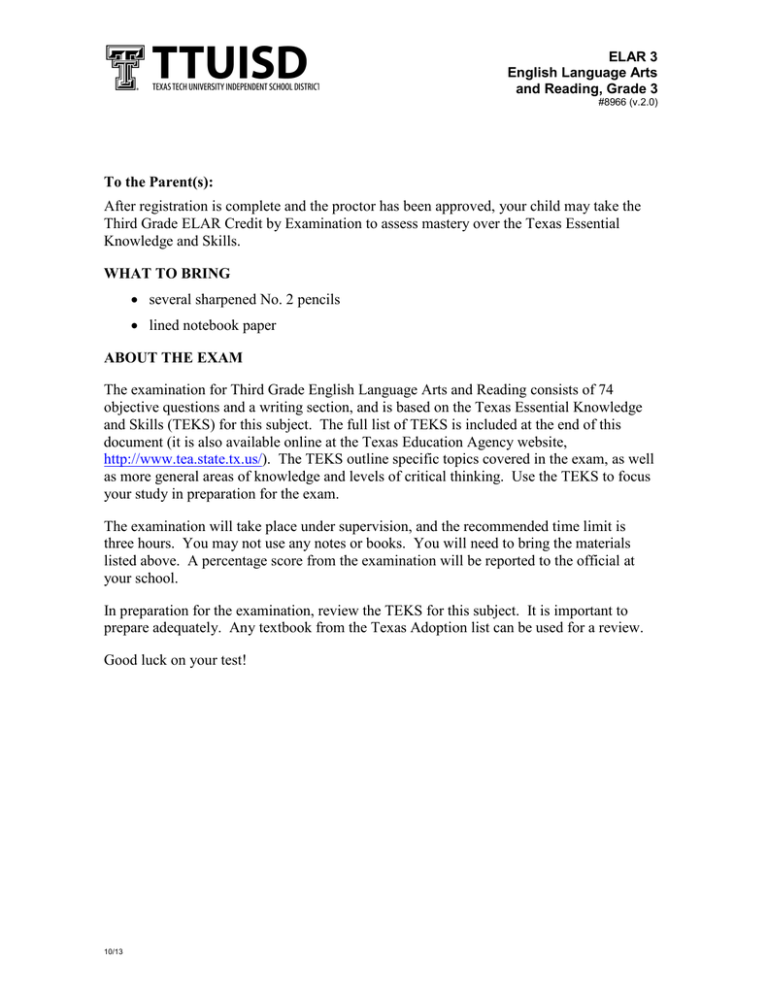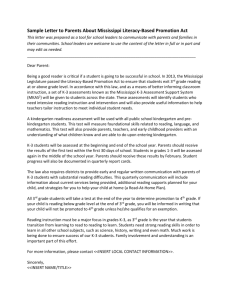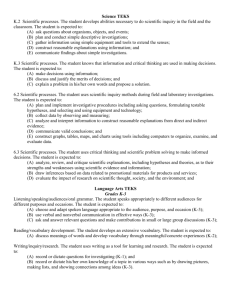After registration is complete and the proctor has been approved,... Third Grade ELAR Credit by Examination to assess mastery over... To the Parent(s):
advertisement

ELAR 3 English Language Arts and Reading, Grade 3 #8966 (v.2.0) To the Parent(s): After registration is complete and the proctor has been approved, your child may take the Third Grade ELAR Credit by Examination to assess mastery over the Texas Essential Knowledge and Skills. WHAT TO BRING • several sharpened No. 2 pencils • lined notebook paper ABOUT THE EXAM The examination for Third Grade English Language Arts and Reading consists of 74 objective questions and a writing section, and is based on the Texas Essential Knowledge and Skills (TEKS) for this subject. The full list of TEKS is included at the end of this document (it is also available online at the Texas Education Agency website, http://www.tea.state.tx.us/). The TEKS outline specific topics covered in the exam, as well as more general areas of knowledge and levels of critical thinking. Use the TEKS to focus your study in preparation for the exam. The examination will take place under supervision, and the recommended time limit is three hours. You may not use any notes or books. You will need to bring the materials listed above. A percentage score from the examination will be reported to the official at your school. In preparation for the examination, review the TEKS for this subject. It is important to prepare adequately. Any textbook from the Texas Adoption list can be used for a review. Good luck on your test! 10/13 Texas Essential Knowledge and Skills ELAR 3 – English Language Arts and Reading, Grade 3 §110.5. English Language Arts and Reading, Grade 3. (a) Introduction. (1) In Grade 3, students read and write more independently than in any previous grade and spend significant blocks of time engaged in reading and writing on their own as well as in assigned tasks and projects. Students listen critically to spoken messages, think about their own contributions to discussions, and plan their oral presentations. Third grade students read grade-level material fluently and with comprehension. Students use root words, prefixes, suffixes, and derivational endings to recognize words. Students demonstrate knowledge of synonyms, antonyms, and multi-meaning words. Students are beginning to distinguish fact from opinion in texts. During class discussions, third grade students support their ideas and inferences by citing portions of the text being discussed. Students read in a variety of genres, including realistic and imaginative fiction, nonfiction, and poetry from classic and contemporary works. Third grade students write with more complex capitalization and punctuation such as proper nouns and commas in a series. Students write with more proficient spelling of contractions and homonyms. Third grade students write longer and more elaborate sentences and organize their writing into larger units of text. Students write several drafts to produce a final product. Students revise their writing to improve coherence, progression, and logic, and edit final drafts to reflect standard grammar and usage. Students master manuscript writing and may begin to use cursive writing. (2) For third grade students whose first language is not English, the students' native language serves as a foundation for English language acquisition. (3) The essential knowledge and skills as well as the student expectations for Grade 3 are described in subsection (b) of this section. Following each statement of a student expectation is a parenthetical notation that indicates the additional grades at which these expectations are demonstrated at increasingly sophisticated levels. (4) To meet Public Education Goal 1 of the Texas Education Code, §4.002, which states, "The students in the public education system will demonstrate exemplary performance in the reading and writing of the English language," students will accomplish the essential knowledge and skills as well as the student expectations for Grade 3 as described in subsection (b) of this section. (5) To meet Texas Education Code, §28.002(h), which states, ". . . each school district shall foster the continuation of the tradition of teaching United States and Texas history and the free enterprise system in regular subject matter and in reading courses and in the adoption of textbooks," students will be provided oral and written narratives as well as other informational texts that can help them to become thoughtful, active citizens who appreciate the basic democratic values of our state and nation. (6) It is the goal of the state that all children read on grade level by the end of Grade 3 and continue to read on grade level or higher throughout their schooling. (b) Knowledge and skills. (1) Listening/speaking/purposes. The student listens attentively and engages actively in various oral language experiences. The student is expected to: (A) determine the purpose(s) for listening such as to get information, to solve problems, and to enjoy and appreciate (K-3); (B) respond appropriately and courteously to directions and questions (K-3); (C) participate in rhymes, songs, conversations, and discussions (K-3); (D) listen critically to interpret and evaluate (K-3); (E) listen responsively to stories and other texts read aloud, including selections from classic and contemporary works (K-3); and (F) identify the musical elements of literary language, including its rhymes, repeated sounds, or instances of onomatopoeia (2-3). (2) Listening/speaking/culture. The student listens and speaks to gain knowledge of his/her own culture, the culture of others, and the common elements of cultures. The student is expected to: (A) connect experiences and ideas with those of others through speaking and listening (K-3); and (B) compare language and oral traditions (family stories) that reflect customs, regions, and cultures (K-3). (3) Listening/speaking/audiences/oral grammar. The student speaks appropriately to different audiences for different purposes and occasions. The student is expected to: (A) choose and adapt spoken language appropriate to the audience, purpose, and occasion, including use of appropriate volume and rate (K-3); (B) use verbal and nonverbal communication in effective ways such as making announcements, giving directions, or making introductions (K-3); (C) ask and answer relevant questions and make contributions in small or large group discussions (K-3); (D) present dramatic interpretations of experiences, stories, poems, or plays (K-3); and (E) gain increasing control of grammar when speaking such as using subject-verb agreement, complete sentences, and correct tense (K-3). 2 (4) Listening/speaking/communication. The student communicates clearly by putting thoughts and feelings into spoken words. The student is expected to: (A) use vocabulary to describe clearly ideas, feelings, and experiences (K-3); (B) clarify and support spoken messages using appropriate props, including objects, pictures, and charts (K-3); and (C) retell a spoken message by summarizing or clarifying (K-3). (5) Reading/word identification. The student uses a variety of word identification strategies. The student is expected to: (A) decode by using all letter-sound correspondences within a word (1-3); (B) blend initial letter-sounds with common vowel spelling patterns to read words (1-3); (C) identify multisyllabic words by using common syllable patterns (1-3); (D) use root words and other structural cues such as prefixes, suffixes, and derivational endings to recognize words (3); (E) use knowledge of word order (syntax) and context to support word identification and confirm word meaning (1-3); and (F) read both regular and irregular words automatically such as through multiple opportunities to read and reread (1-3). (6) Reading/fluency. The student reads with fluency and understanding in texts at appropriate difficulty levels. The student is expected to: (A) read regularly in independent-level materials (texts in which no more than approximately 1 in 20 words is difficult for the reader) (3); (B) read regularly in instructional-level materials that are challenging but manageable (texts in which no more than approximately 1 in 10 words is difficult for the reader; the "typical" third grader reads 80 wpm) (3); (C) read orally from familiar texts with fluency (accuracy, expression, appropriate phrasing, and attention to punctuation) (3); (D) self-select independent-level reading such as by drawing on personal interests, by relying on knowledge of authors and different types of texts, and/or by estimating text difficulty (1-3); and (E) read silently for increasing periods of time (2-3). (7) Reading/variety of texts. The student reads widely for different purposes in varied sources. The student is expected to: (A) read classic and contemporary works (2-8); (B) read from a variety of genres for pleasure and to acquire information from both print and electronic sources (2-3); and (C) read to accomplish various purposes, both assigned and self-selected (2-3). (8) Reading/vocabulary development. The student develops an extensive vocabulary. The student is expected to: (A) develop vocabulary by listening to and discussing both familiar and conceptually challenging selections read aloud (K-3); (B) develop vocabulary through reading (2-3); (C) use resources and references such as beginners' dictionaries, glossaries, available technology, and context to build word meanings and to confirm pronunciations of words (2-3); and (D) demonstrate knowledge of synonyms, antonyms, and multi-meaning words (for example, by sorting, classifying, and identifying related words) (3). (9) Reading/comprehension. The student uses a variety of strategies to comprehend selections read aloud and selections read independently. The student is expected to: (A) use prior knowledge to anticipate meaning and make sense of texts (K-3); (B) establish purposes for reading and listening such as to be informed, to follow directions, and to be entertained (K-3); (C) retell or act out the order of important events in stories (K-3); (D) monitor his/her own comprehension and act purposefully when comprehension breaks down using such strategies as rereading, searching for clues, and asking for help (1-3); (E) draw and discuss visual images based on text descriptions (1-3); (F) make and explain inferences from texts such as determining important ideas, causes and effects, making predictions, and drawing conclusions (1-3); (G) identify similarities and differences across texts such as in topics, characters, and themes (3); (H) produce summaries of text selections (2-3); (I) represent text information in different ways, including story maps, graphs, and charts (2-3); (J) distinguish fact from opinion in various texts, including news stories and advertisements (3); and (K) practice different kinds of questions and tasks, including test-like comprehension questions (3). 3 (10) Reading/literary response. The student responds to various texts. The student is expected to: (A) respond to stories and poems in ways that reflect understanding and interpretation in discussion (speculating, questioning), in writing, and through movement, music, art, and drama (2-3); (B) demonstrate understanding of informational text in a variety of ways through writing, illustrating, developing demonstrations, and using available technology (2-3); (C) support interpretations or conclusions with examples drawn from text (2-3); and (D) connect ideas and themes across texts (1-3). (11) Reading/text structures/literary concepts. The student analyzes the characteristics of various types of texts. The student is expected to: (A) distinguish different forms of texts, including lists, newsletters, and signs and the functions they serve (K-3); (B) distinguish fiction from nonfiction, including fact and fantasy (K-3); (C) recognize the distinguishing features of familiar genres, including stories, poems, and informational texts (1-3); (D) compare communication in different forms such as contrasting a dramatic performance with a print version of the same story or comparing story variants (2-8); (E) understand and identify literary terms such as title, author, illustrator, playwright, theater, stage, act, dialogue, and scene across a variety of literary forms (texts) (3-5); (F) understand literary forms by recognizing and distinguishing among such types of text as stories, poems, myths, fables, tall tales, limericks, plays, biographies, and autobiographies (3-7); (G) compare communications in different forms, including contrasting a dramatic performance with a print version of the same story (3); (H) analyze characters, including their traits, feelings, relationships, and changes (1-3); (I) identify the importance of the setting to a story's meaning (1-3); and (J) recognize the story problem(s) or plot (1-3). (12) Reading/inquiry/research. The student generates questions and conducts research using information from various sources. The student is expected to: (A) identify relevant questions for inquiry such as "What Native American tribes inhabit(ed) Texas?" (K-3); (B) use alphabetical order to locate information (1-3); (C) recognize and use parts of a book to locate information, including table of contents, chapter titles, guide words, and indices (1-3); (D) use multiple sources, including print such as an encyclopedia, technology, and experts, to locate information that addresses questions (2-3); (E) interpret and use graphic sources of information, including maps, charts, graphs, and diagrams (2-3); (F) locate and use important areas of the library media center (2-3); (G) organize information in systematic ways, including notes, charts, and labels (3); (H) demonstrate learning through productions and displays such as oral and written reports, murals, and dramatizations (2-3); (I) use compiled information and knowledge to raise additional, unanswered questions (3); and (J) draw conclusions from information gathered (K-3). (13) Reading/culture. The student reads to increase knowledge of his/her own culture, the culture of others, and the common elements of culture. The student is expected to: (A) connect his/her own experiences with the life experiences, language, customs, and culture of others (K-3); and (B) compare experiences of characters across cultures (K-3). (14) Writing/purposes. The student writes for a variety of audiences and purposes and in various forms. The student is expected to: (A) write to record ideas and reflections (K-3); (B) write to discover, develop, and refine ideas (1-3); (C) write to communicate with a variety of audiences (1-3); and (D) write in different forms for different purposes such as lists to record, letters to invite or thank, and stories or poems to entertain (1-3). (15) Writing/penmanship/capitalization/punctuation. The student composes original texts using the conventions of written language such as capitalization and penmanship to communicate clearly. The student is expected to: (A) gain more proficient control of all aspects of penmanship (3); and 4 (B) use capitalization and punctuation such as commas in a series, apostrophes in contractions such as can't and possessives such as Robin's, quotation marks, proper nouns, and abbreviations with increasing accuracy (3). (16) Writing/spelling. The student spells proficiently. The student is expected to: (A) write with more proficient spelling of regularly spelled patterns such as consonant-vowel-consonant (CVC) (hop), consonant-vowelconsonant-silent e (CVCe) (hope), and one-syllable words with blends (drop) (1-3); (B) spell multisyllabic words using regularly spelled phonogram patterns (3); (C) write with more proficient spelling of inflectional endings, including plurals and past tense and words that drop the final e when such endings as -ing, -ed, or -able are added (3); (D) write with more proficient use of orthographic patterns and rules such as oil/toy, match/speech, badge/cage, consonant doubling, dropping e, and changing y to i (3); (E) write with more proficient spelling of contractions, compounds, and homonyms such as hair-hare and bear-bare (3); (F) write with accurate spelling of syllable constructions such as closed, open, consonant before -le, and syllable boundary patterns (3-6); (G) spell words ending in -tion and -sion such as station and procession (3); and (H) use resources to find correct spellings, synonyms, or replacement words (1-3). (17) Writing/grammar/usage. The student composes meaningful texts applying knowledge of grammar and usage. The student is expected to: (A) use correct irregular plurals such as sheep (3); (B) use singular and plural forms of regular nouns and adjust verbs for agreement (3); (C) compose elaborated sentences in written texts and use the appropriate end punctuation (3); (D) compose sentences with interesting, elaborated subjects (2-3); and (E) edit writing toward standard grammar and usage, including subject-verb agreement; pronoun agreement, including pronouns that agree in number; and appropriate verb tenses, including to be, in final drafts (2-3). (18) Writing/writing processes. The student selects and uses writing processes for self-initiated and assigned writing. The student is expected to: (A) generate ideas for writing by using prewriting techniques such as drawing and listing key thoughts (2-3); (B) develop drafts (1-3); (C) revise selected drafts for varied purposes, including to achieve a sense of audience, precise word choices, and vivid images (1-3); (D) edit for appropriate grammar, spelling, punctuation, and features of polished writing (2-3); (E) use available technology for aspects of writing such as word processing, spell checking, and printing (2-3); and (F) demonstrate understanding of language use and spelling by bringing selected pieces frequently to final form, "publishing" them for audiences (2-3). (19) Writing/evaluation. The student evaluates his/her own writing and the writing of others. The student is expected to: (A) identify the most effective features of a piece of writing using criteria generated by the teacher and class (1-3); (B) respond constructively to others' writing (1-3); (C) determine how his/her own writing achieves its purposes (1-3); (D) use published pieces as models for writing (2-3); and (E) review a collection of his/her own written work to monitor growth as a writer (2-3). (20) Writing/inquiry/research. The student uses writing as a tool for learning and research. The student is expected to: (A) write or dictate questions for investigating (2-3); (B) record his/her own knowledge of a topic in a variety of ways such as by drawing pictures, making lists, and showing connections among ideas (K-3); (C) take simple notes from relevant sources such as classroom guests, books, and media sources (2-3); and (D) compile notes into outlines, reports, summaries, or other written efforts using available technology (2-3). Source: The provisions of this §110.5 adopted to be effective September 1, 1998, 22 TexReg 7549 5




